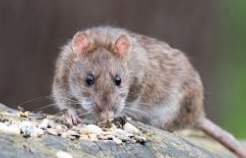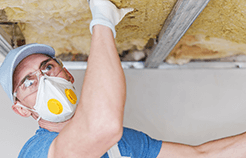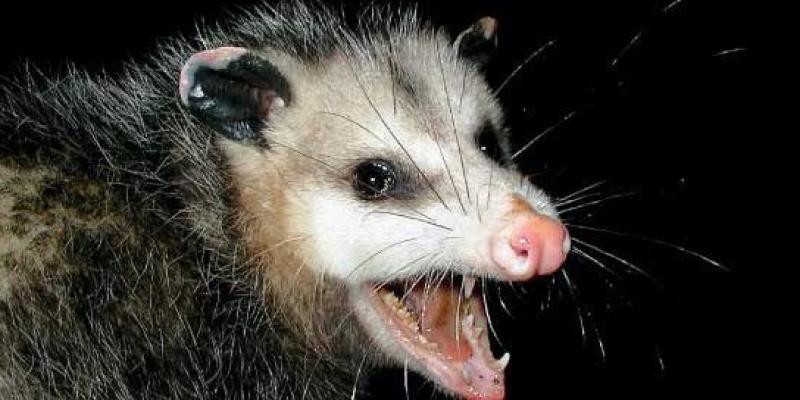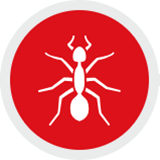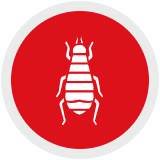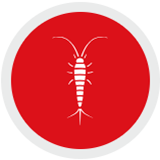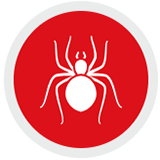If you have opossums in your home or inside another building on your property, the infestation should be immediately apparent. These animals are loud and less confined to nocturnal schedules than some rodents, so they are usually quite visible, even during the day. Should your infestation be a group of opossums, you may notice any combination of the following five signs.
1. Opossum Damage: Damage to the Building Exterior
Because opossums usually enter a building by climbing, you may notice exterior damage first. Often, opossum damage takes the form of torn up shingles and ripped soffit on your rooftop. An opossum infestation may also impact your siding, eaves, and gutter system.
2. Disappearing Pet Food
Opossums are particularly drawn to cat food. If you have cats, especially any outdoor cats, you may notice that their food disappears more quickly when you have an opossum infestation. If you suspect an opossum infestation, take measures to protect your cats who could become injured in a fight with an opossum.
3. Frequent Animal Vocalizations
Opossums have a wide range of vocalizations, including hissing and shrieking. Mother opossums also make clicking or lip smacking sounds to call their babies. If you notice these noises when inside a building, chances are you have an infestation or a single opossum trapped inside.
4. Loud Scratching Noises
As opossums nest, they make lots of ripping, scuttling, and scratching noises. These noises can sound similar to rats or mice, but you will likely notice that the noises seem louder because they’re created by a bigger animal.
Additionally, you may notice scratching across a wider area with an opossum infestation than with any other rodent problem because opossums do not stick solely to the edges of the attic space.
5. Pervasive Unpleasant Smells
One of the most distinct signs of an opossum infestation is the smell. Opossums defecate more frequently than most mammals and their droppings can be as large as a house cat’s. These wet droppings can soak into insulation and building materials, causing a distinctly unpleasant odor.
Opossums can also become trapped by wiring or other architectural elements and may die there. If you have a dead opossum in your attic, you’ll know by the strong smell of decay.
When to call for professional opossum removal (wildlife control)
If you find yourself with an opossum in the house, please call a professional wildlife removal technician immediately. Opossums carry diseases such as leptospirosis, tuberculosis, relapsing fever, tularemia, spotted fever, toxoplasmosis, coccidiosis, trichomoniasis, and Chagas disease. They may also be infested with fleas, ticks, mites, and lice which can spread to the surrounding areas of the home. Also, opossums are hosts for cat and dog fleas, especially in urban environments. Therefore it is best to professionally remove an opossum from your house, garage, deck, attic or crawl space as quickly as possible.
Common Locations for Opossums:
Opossum in house
Opossums are curious little beasts and can’t see very well. An open door or window may be an invitation for an opossum to enter your home. In our wooded neighborhoods here in the Seattle area, homes are built in opossum habitat and are close enough to be tempting shelters. You may find an opossum in your home, especially if you have a “doggie door” for your pets.
Opossum in attic
Attics are warm and dry places of refuge for opossums. Many homeowners who live in or near wooded areas come across opossums in the attic, and it can be a scary surprise. It is important to check for possible entry points all through your home to ensure that once the opossum is removed, none will return in its place. An opossum in the attic can be very dangerous, and it is advised to hire a professional to remove it safely.
Opossum in garage
When we open and close the garage door, we may be inviting unexpected guests. An opossum may wander in to your garage and find a wonderful array of dark places to hide. There may even be access to food or water. It is not unusual to find an opossum living in unattached or even attached garages. You may be able to scare it away, but it would be safest to hire a wildlife expert and eliminate the problem for good.
Opossum in crawl space
Just like the attic, but easier to get to most of the time, crawl spaces make lovely homes for opossums. If you hear shuffling or scratching in your floors, you may have an opossum in your crawl space. Hire a professional wildlife removal expert to crawl down and carefully inspect your crawl space for damage, especially the germ-ridden urine or feces left behind.
Opossum under deck
Probably the easiest part of your home to infest is your deck. There are usually large gaps for easy entry, and it provides shelter from the elements. A professional wildlife removal expert will inspect your homes decks carefully to see if you have an opossum occupant. This is another good situation to let the professionals handle: an angry opossum can and will bite.
Opossum on roof
Opossums are great climbers. If you have trees near your roof, you probably have opossum traffic on your roof. Many construction companies don’t completely seal off the home when building a new house, and many roofing companies don’t look for opportunities to use successful pest-proofing “exclusion techniques” to keep wild animals of all kinds out of your home.
Though we currently don’t provide removal services for opossum, contact our experienced exterminators in Seattle for more helpful insights into pest behavior.
[addtoany]

 (425) 318-7912
(425) 318-7912
 MY ACCOUNT
MY ACCOUNT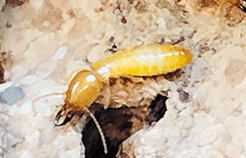
 425-318-7912
425-318-7912